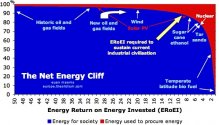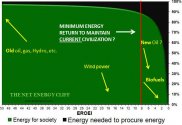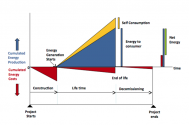I'm not him but, if I understand your comment correctly, you believe solar energy is the solution to EROEI?
Hm, well probably not. This is because while the Sun is, as you've correctly stated, basically sending us energy for free, we can't put that energy to use without spending energy. That is, we need to make solar panels, and therefore we need to create and/or mine the materials that go into solar panels, and that all takes energy. Indeed, shipping that material to a factor and then shipping those panels to a solar farm costs energy. Its very complex to calculate.... which is why we just use EROEI instead.
Solar panels don't last forever, either. Which is why we can say there is a set cost over its lifetime and not just, "basically infinite." As much as I wish solar panels could last forever, they only last 30 years or so. (This is increasing. EROEI of solar panels could go up as their lifetimes increase, provided the materials don't become harder to find.)
This is an article that is a refutation of a previous article (that article calculated EROEI for solar voltaic panels as about 0.8), finding that its about 7-8 (or about 10, honestly. Thats the number I would use)
For context, a civilization requires about EROEI of about 3 or more to progress. The industrial revolution, characterized by very easily attainable coal, saw about EROEI of... hundreds. It was ridiculous. The oil and gas that characterized the 60's, 70's and 80's was at about 40. We today still using oil and gas see EROEI of about 20.
And its a big thing to note, EROEI is not constant across the world! Efficiency of industrial processes play a huge, huge, huge part in all of it. Not to mention availability of fuels. China, for example, has never even sniffed anything like an EROEI of 100 to 1. (Er... historically. Theres actually very good news on this front) The west has. (China's coal peaked at like 40. That was peak EROEI for China)
That said, its not like we're going to run EROEI to zero. Wood, for example, has an EROEI of anywhere between 20 and 60. Its not that wood is particularly energy dense or that burning wood is efficient, its just that wood is trivially cheap for many countries. (Not China, for many reasons. China has bamboo instead.) There are processes that make wood more energy dense but have a lower EROEI, and of course just cutting and burning wood will have a very high EROEI but is incredibly polluting, and so on....
And of course, we see that EROEI is not the driving factor for why we use one source of fuel over another...
The big EROEI savior we have in the future is probably nuclear energy. Its at like, what 100 EROEI? Hey, China's nuclear power development is literally reversing EROEI decline as we speak! (Which is also why its not doom and gloom. We have power sources that are much better. I haven't even talked about wind yet! (order of 50 EROEI... but its just hard to get consistent power from it.))
Also EROEI is very hard to calculate. Gives me a headache.







